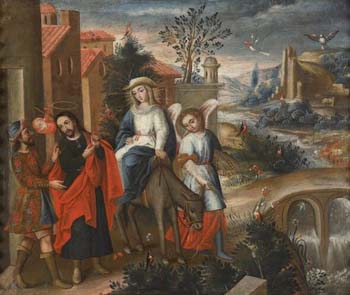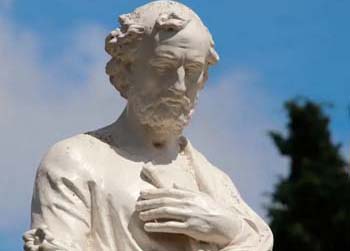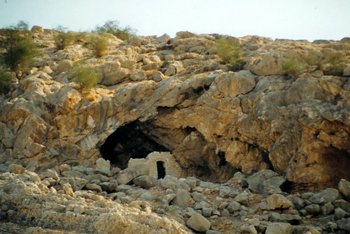Saints of the Day
 |
 |
 |
 |
 |
 |
 |
Humiliation of St. Joseph - December 23-25
- Part II -
- Part II -

After many humiliating refusals,
St. Joseph returns to Our Lady
But this was not what happened because there was ceremony between them, as happens with persons who understand each other's vocation and maintain a certain distance. She could have told him: “Thou hast no guilt in this rejection,” and thus have saved him much agony.
Indeed, she consoled him, but not to the point of preventing him from being sad. Why? Because she knew it was necessary for them to endure those humiliations before the glorification of Christmas Night, which was the Birth of Our Lord and all that would take place in the grotto the next Holy Night.
This is the way it always is. Persons for whom God has very defined plans must pass through great perturbations and have the impression of an indescribable abandonment. After they pass through this trial, they are protected, welcomed and moved forward. St. Joseph was going through one of these abandonments and Our Lady also suffered the discomfort he felt.

St. Joseph suffered a greater sadness for his failure to obtain accommodations
Our Lady was conceived without original sin. Everything leads one to believe, therefore, that she did not have that same weariness as he and was in perfect control of her body. All those physical setbacks did not disturb her. Further, she was much more aware of God’s plans and had no reason to be disturbed.
St. Joseph had the worse part. He was conceived with original sin, subject to tiredness, and also felt a great sadness because he could not find appropriate accommodations for his Wife and the Son of God Who was to be born. This caused a great disturbance in him.
But what was of greater concern for both was that the persons from whom he asked shelter were receiving special graces to say “Yes.” The fact that they rejected that grace to receive the Holy Family was an act of hostility toward the Savior who was to be born. It was a rejection of the good influence of the Angels and of grace.
It was cruel to see a venerable man like St. Joseph asking for a favor and receiving the answer “No.” This rejection reveals a great wickedness of soul. Those wicked rejections were the first offenses the Child God received from His Chosen People on the eve of the day of His Birth. This gives us a first glimpse at His future relationship with the world.
This would greatly afflict Our Lady and St. Joseph. They were much more concerned about the Divine Infant than about themselves. In this particular point, Our Lady suffered more than St. Joseph. It was the light of Christ – the lumen Christi – that was rejected. For Our Lady it was the beginning of the Passion of Our Lord. She saw the shadow of the Cross already in those rejections. To me this is impressive and moving.

A shepherd's cave in the hills of Bethlehem
When he was a boy he had lived in Bethlehem. Someone told me that he was the youngest of his brothers. When they would persecute him, he would run to that grotto. So, it was to that grotto that he brought his Family.
First, he went there when he was rejected by his brothers; but now he retired there when he was rejected by the city where he had been born. Twice St. Joseph, the Protector of the One, Holy, Apostolic and Roman Church, was reduced to this extreme! These are the designs of God: He makes the men whom He loves very much to pass through trials of this nature once in a while, or even frequently.
Then, Anne Catherine Emmerick gives the history of the grotto. In that grotto many great events had occurred linked to persons of the Old Testament, all of them in some way prophetic of the great Event that would later take place there. She continues:
“The sun was already low when they reached the entrance of the cave. The young she-ass, which had left them at Joseph's ancestral house to run round the outside of the town, met them as soon as they arrived here and gamboled joyfully round them. ‘Look,' said the Blessed Virgin to Joseph, 'it is certainly the will of God that we should go in here.'"

He ties the pack donkey to the entrance of the cave
“Joseph put the pack-donkey under the shelter by the entrance of the cave and prepared a place for the Blessed Virgin to sit and rest while he kindled a light, opened the wickerwork door of the cave, and went into it. The entrance into the cave was narrow, obstructed by bundles of straw like rushes, stacked against the walls with brown mats hanging over them. Inside, the cave was encumbered with a quantity of things. Joseph cleared out as much as was necessary to make a comfortable resting-place for the Blessed Virgin at the eastern end of the cave.”
It is from the East that the sun rises; the Child Jesus, the Sun of Justice and Sanctity, should be born in the East.
“Then he fastened a burning lamp in the wall of the dark cave and led the Blessed Virgin in. She lay down on the couch of rugs and bundles that St. Joseph had prepared for her. He apologized most humbly for the poorness of the shelter, but Mary was joyful and contented in her inmost spirit.”
Catherine Emmerick reports what St. Joseph said, but does not give the answer of Our Lady. We have already seen that on the occasion of the Conception of the Word, she said nothing to St. Joseph, which caused him a tremendous perplexity. Here also we see that he was undergoing a great perplexity.
Continued

 | |
|
|
The texts of both the biographical data and the comments come from personal notes taken by Atila S. Guimarães from 1964 to 1995. Given the fact that the source is a personal notebook, it is possible that at times the biographic notes transcribed here will not rigorously follow the original text read by Prof. Plinio. The commentaries have also been adapted and translated for TIA’s site.


